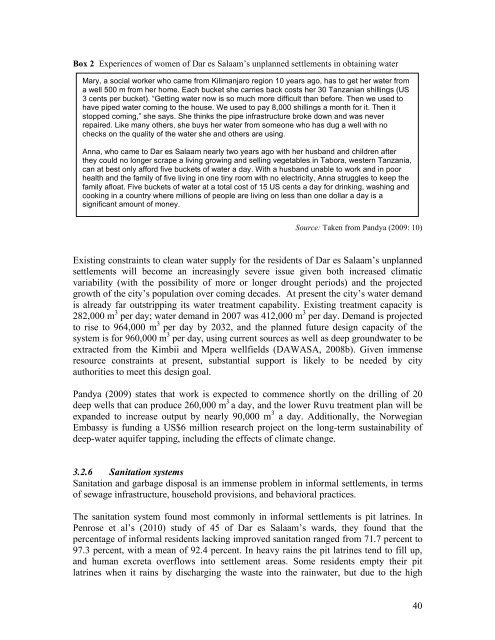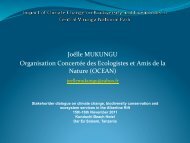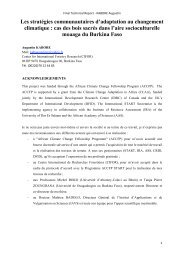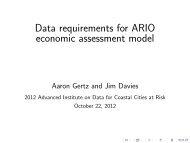Urban Poverty & Climate Change in Dar es Salaam, Tanzania:
Urban Poverty & Climate Change in Dar es Salaam, Tanzania:
Urban Poverty & Climate Change in Dar es Salaam, Tanzania:
You also want an ePaper? Increase the reach of your titles
YUMPU automatically turns print PDFs into web optimized ePapers that Google loves.
Box 2 Experienc<strong>es</strong> of women of <strong>Dar</strong> <strong>es</strong> <strong>Salaam</strong>’s unplanned settlements <strong>in</strong> obta<strong>in</strong><strong>in</strong>g water<br />
Mary, a social worker who came from Kilimanjaro region 10 years ago, has to get her water from<br />
a well 500 m from her home. Each bucket she carri<strong>es</strong> back costs her 30 <strong>Tanzania</strong>n shill<strong>in</strong>gs (US<br />
3 cents per bucket). “Gett<strong>in</strong>g water now is so much more difficult than before. Then we used to<br />
have piped water com<strong>in</strong>g to the house. We used to pay 8,000 shill<strong>in</strong>gs a month for it. Then it<br />
stopped com<strong>in</strong>g,” she says. She th<strong>in</strong>ks the pipe <strong>in</strong>frastructure broke down and was never<br />
repaired. Like many others, she buys her water from someone who has dug a well with no<br />
checks on the quality of the water she and others are us<strong>in</strong>g.<br />
Anna, who came to <strong>Dar</strong> <strong>es</strong> <strong>Salaam</strong> nearly two years ago with her husband and children after<br />
they could no longer scrape a liv<strong>in</strong>g grow<strong>in</strong>g and sell<strong>in</strong>g vegetabl<strong>es</strong> <strong>in</strong> Tabora, w<strong>es</strong>tern <strong>Tanzania</strong>,<br />
can at b<strong>es</strong>t only afford five buckets of water a day. With a husband unable to work and <strong>in</strong> poor<br />
health and the family of five liv<strong>in</strong>g <strong>in</strong> one t<strong>in</strong>y room with no electricity, Anna struggl<strong>es</strong> to keep the<br />
family afloat. Five buckets of water at a total cost of 15 US cents a day for dr<strong>in</strong>k<strong>in</strong>g, wash<strong>in</strong>g and<br />
cook<strong>in</strong>g <strong>in</strong> a country where millions of people are liv<strong>in</strong>g on l<strong>es</strong>s than one dollar a day is a<br />
significant amount of money.<br />
Source: Taken from Pandya (2009: 10)<br />
Exist<strong>in</strong>g constra<strong>in</strong>ts to clean water supply for the r<strong>es</strong>idents of <strong>Dar</strong> <strong>es</strong> <strong>Salaam</strong>’s unplanned<br />
settlements will become an <strong>in</strong>creas<strong>in</strong>gly severe issue given both <strong>in</strong>creased climatic<br />
variability (with the possibility of more or longer drought periods) and the projected<br />
growth of the city’s population over com<strong>in</strong>g decad<strong>es</strong>. At pr<strong>es</strong>ent the city’s water demand<br />
is already far outstripp<strong>in</strong>g its water treatment capability. Exist<strong>in</strong>g treatment capacity is<br />
282,000 m 3 per day; water demand <strong>in</strong> 2007 was 412,000 m 3 per day. Demand is projected<br />
to rise to 964,000 m 3 per day by 2032, and the planned future d<strong>es</strong>ign capacity of the<br />
system is for 960,000 m 3 per day, us<strong>in</strong>g current sourc<strong>es</strong> as well as deep groundwater to be<br />
extracted from the Kimbii and Mpera wellfields (DAWASA, 2008b). Given immense<br />
r<strong>es</strong>ource constra<strong>in</strong>ts at pr<strong>es</strong>ent, substantial support is likely to be needed by city<br />
authoriti<strong>es</strong> to meet this d<strong>es</strong>ign goal.<br />
Pandya (2009) stat<strong>es</strong> that work is expected to commence shortly on the drill<strong>in</strong>g of 20<br />
deep wells that can produce 260,000 m 3 a day, and the lower Ruvu treatment plan will be<br />
expanded to <strong>in</strong>crease output by nearly 90,000 m 3 a day. Additionally, the Norwegian<br />
Embassy is fund<strong>in</strong>g a US$6 million r<strong>es</strong>earch project on the long-term susta<strong>in</strong>ability of<br />
deep-water aquifer tapp<strong>in</strong>g, <strong>in</strong>clud<strong>in</strong>g the effects of climate change.<br />
3.2.6 Sanitation systems<br />
Sanitation and garbage disposal is an immense problem <strong>in</strong> <strong>in</strong>formal settlements, <strong>in</strong> terms<br />
of sewage <strong>in</strong>frastructure, household provisions, and behavioral practic<strong>es</strong>.<br />
The sanitation system found most commonly <strong>in</strong> <strong>in</strong>formal settlements is pit latr<strong>in</strong><strong>es</strong>. In<br />
Penrose et al’s (2010) study of 45 of <strong>Dar</strong> <strong>es</strong> <strong>Salaam</strong>’s wards, they found that the<br />
percentage of <strong>in</strong>formal r<strong>es</strong>idents lack<strong>in</strong>g improved sanitation ranged from 71.7 percent to<br />
97.3 percent, with a mean of 92.4 percent. In heavy ra<strong>in</strong>s the pit latr<strong>in</strong><strong>es</strong> tend to fill up,<br />
and human excreta overflows <strong>in</strong>to settlement areas. Some r<strong>es</strong>idents empty their pit<br />
latr<strong>in</strong><strong>es</strong> when it ra<strong>in</strong>s by discharg<strong>in</strong>g the waste <strong>in</strong>to the ra<strong>in</strong>water, but due to the high<br />
40







